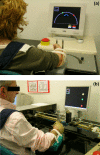Design strategies to improve patient motivation during robot-aided rehabilitation
- PMID: 17309790
- PMCID: PMC1805445
- DOI: 10.1186/1743-0003-4-3
Design strategies to improve patient motivation during robot-aided rehabilitation
Abstract
Background: Motivation is an important factor in rehabilitation and frequently used as a determinant of rehabilitation outcome. Several factors can influence patient motivation and so improve exercise adherence. This paper presents the design of two robot devices for use in the rehabilitation of upper limb movements, that can motivate patients during the execution of the assigned motor tasks by enhancing the gaming aspects of rehabilitation. In addition, a regular review of the obtained performance can reinforce in patients' minds the importance of exercising and encourage them to continue, so improving their motivation and consequently adherence to the program. In view of this, we also developed an evaluation metric that could characterize the rate of improvement and quantify the changes in the obtained performance.
Methods: Two groups (G1, n = 8 and G2, n = 12) of patients with chronic stroke were enrolled in a 3-week rehabilitation program including standard physical therapy (45 min. daily) plus treatment by means of robot devices (40 min., twice daily) respectively for wrist (G1) and elbow-shoulder movements (G2). Both groups were evaluated by means of standard clinical assessment scales and the new robot measured evaluation metric. Patients' motivation was assessed in 9/12 G2 patients by means of the Intrinsic Motivation Inventory (IMI) questionnaire.
Results: Both groups reduced their motor deficit and showed a significant improvement in clinical scales and the robot measured parameters. The IMI assessed in G2 patients showed high scores for interest, usefulness and importance subscales and low values for tension and pain subscales.
Conclusion: Thanks to the design features of the two robot devices the therapist could easily adapt training to the individual by selecting different difficulty levels of the motor task tailored to each patient's disability. The gaming aspects incorporated in the two rehabilitation robots helped maintain patients' interest high during execution of the assigned tasks by providing feedback on performance. The evaluation metric gave a precise measure of patients' performance and thus provides a tool to help therapists promote patient motivation and hence adherence to the training program.
Figures




Similar articles
-
Robotic techniques for upper limb evaluation and rehabilitation of stroke patients.IEEE Trans Neural Syst Rehabil Eng. 2005 Sep;13(3):311-24. doi: 10.1109/TNSRE.2005.848352. IEEE Trans Neural Syst Rehabil Eng. 2005. PMID: 16200755 Clinical Trial.
-
Taking a lesson from patients' recovery strategies to optimize training during robot-aided rehabilitation.IEEE Trans Neural Syst Rehabil Eng. 2012 May;20(3):276-85. doi: 10.1109/TNSRE.2012.2195679. IEEE Trans Neural Syst Rehabil Eng. 2012. PMID: 22623406
-
Virtual reality to augment robot-assisted gait training in non-ambulatory patients with a subacute stroke: a pilot randomized controlled trial.Eur J Phys Rehabil Med. 2018 Jun;54(3):397-407. doi: 10.23736/S1973-9087.17.04735-9. Epub 2017 Dec 21. Eur J Phys Rehabil Med. 2018. PMID: 29265791 Clinical Trial.
-
Motor recovery strategies after stroke.Top Stroke Rehabil. 2004 Spring;11(2):12-22. doi: 10.1310/RK4A-6ETG-K8RL-3XA7. Top Stroke Rehabil. 2004. PMID: 15118963 Review.
-
A review of technological and clinical aspects of robot-aided rehabilitation of upper-extremity after stroke.Disabil Rehabil Assist Technol. 2016;11(4):263-80. doi: 10.3109/17483107.2014.1002539. Epub 2015 Jan 20. Disabil Rehabil Assist Technol. 2016. PMID: 25600057 Review.
Cited by
-
Characterization and wearability evaluation of a fully portable wrist exoskeleton for unsupervised training after stroke.J Neuroeng Rehabil. 2020 Oct 7;17(1):132. doi: 10.1186/s12984-020-00749-4. J Neuroeng Rehabil. 2020. PMID: 33028354 Free PMC article.
-
Functional MRI in Conjunction with a Novel MRI-compatible Hand-induced Robotic Device to Evaluate Rehabilitation of Individuals Recovering from Hand Grip Deficits.J Vis Exp. 2019 Nov 23;(153):10.3791/59420. doi: 10.3791/59420. J Vis Exp. 2019. PMID: 31814610 Free PMC article.
-
Wearable Robotic Gait Training in Persons with Multiple Sclerosis: A Satisfaction Study.Sensors (Basel). 2021 Jul 20;21(14):4940. doi: 10.3390/s21144940. Sensors (Basel). 2021. PMID: 34300677 Free PMC article.
-
Will Your Next Therapist Be a Robot?-A Review of the Advancements in Robotic Upper Extremity Rehabilitation.Sensors (Basel). 2023 May 25;23(11):5054. doi: 10.3390/s23115054. Sensors (Basel). 2023. PMID: 37299781 Free PMC article. Review.
-
Feasibility of the adaptive and automatic presentation of tasks (ADAPT) system for rehabilitation of upper extremity function post-stroke.J Neuroeng Rehabil. 2011 Aug 3;8:42. doi: 10.1186/1743-0003-8-42. J Neuroeng Rehabil. 2011. PMID: 21813010 Free PMC article. Clinical Trial.
References
-
- Volpe B, Krebs HI, Hogan N, Edelstein OTRL, Diels C, Aisen M. A novel approach to stroke rehabilitation: robot-aided sensorimotor stimulation. Neurology. 2000;54:1938–1944. - PubMed
-
- Burgar CG, Lum PS, Shor PC, Machiel Van der Loos HF. Development of robots for rehabilitation therapy: the Palo Alto VA/Stanford experience. J Rehabil Res Dev. 2000;37:663–673. - PubMed
Publication types
MeSH terms
LinkOut - more resources
Full Text Sources
Other Literature Sources
Medical

